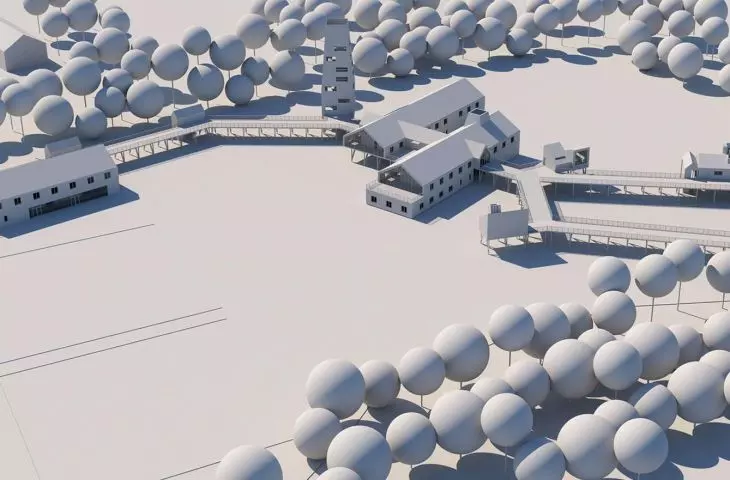Work submitted for the competition
"Best Diploma Architecture"
The subject of the thesis is the design of an astronomical observatory in the Dark Sky Refuge in Chalin. It is one of five locations in Poland covered by active protection of the sky - a unique place in the whole country. Light pollution is among the most serious and widespread forms of environmental pollution. It adversely affects both humans and animals and even plants - among other things, by disrupting the natural cycle of darkness and light. At the same time, the problem of light pollution is quite rarely addressed in public debates, and the measures we take to counter it are insufficient.
land development, diagrams showing the main assumptions of the urban planning concept
© Mateusz Paszkiewicz
The purpose of this project is to develop the existing Dark Sky Ostoja Dark Sky area and create a recreational and educational space on it, which will complement and enrich the didactic offer proposed by the Nature Education Center building adjacent to the plot. The newly designed space also aims to create a place that encourages both the acquisition of knowledge of ecology and nature issues, as well as the promotion of astrotourism. In addition, due to the conservation conditions covering the developed area, the primary goal is to preserve the transparency of the sky full of stars, to bring the problem of light pollution closer and to present the possibility of creating spaces that are in harmony with the surrounding nature.
view of the observatory building
© Mateusz Paszkiewicz
After analyzing the collected materials on the area covered by the study boundary, a conceptual design was prepared on an architectural and construction scale of the observatory, which is part of the complex of buildings located along the route of the newly designed didactic path in the form of an above-ground tract. The designed architecture fits into the natural context, does not violate the existing ecosystem and exemplifies both environmentally and user-friendly solutions.
view of the observation booths
© Mateusz Paszkiewicz
The analysis of nodal points, both in space and on the sky map, and the determination of the connections between them in the context of the terrain on which the facility is being built and its main function, resulted in the routing of the above-ground nature trail in a layout that reflects the shape of one of the most recognizable star systems - the Great Vector.
first floor plan, science building
© Mateusz Paszkiewicz
Light, shadow and twilight play an important role in the perception of architecture. Darkness gives space and allows freedom of interpretation. Depending on the sensitivity of the user, it can be interpreted differently. It is a phenomenon through which a person puts the sense of sight to sleep, activating the others: smell, touch and hearing. The open area of the developed site provided an opportunity to use all these assets. The possibility of communing with light and darkness is provided not only by the buildings of the observatory, the observation tower or the thoughtful forms of view openings in the individual buildings. Architecture in the Ostoja blends with nature, and the attention of visitors is directed to the varied reactions of representatives of the flora and fauna to changing light conditions ("day" and "night" gardens and sensory gardens are envisaged).
South elevation and B-B cross-section of the science building
© Mateusz Paszkiewicz
The basis for the newly designed building is the desire to inscribe it into the existing space in a way that will make it an element of the surroundings, and not a set of random solids interfering with its perception. Therefore, the premise of the architectural concept is to create a development that, despite its contemporary appearance, is open to traditional structural and formal solutions. The buildings have features of organic architecture. The wooden facades of the buildings relate to their surroundings. In addition, sloping roofs, wooden construction and glass are the leitmotifs of the design. Thanks to them, the new architecture maintains a consistent character despite its diversity. Each designed building, although created according to the same rules - a simple and clear plan, a cuboid body, a sloping roof and a homogeneous facade material - has its own individual character and unique form.
Western elevation and A-A cross-section of the science building
© Mateusz Paszkiewicz
Mateusz PASZKIEWICZ
Illustrations: © Author









































